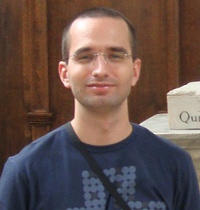Lucas Antiqueira: Difference between revisions
From Santa Fe Institute Events Wiki
No edit summary |
No edit summary |
||
| Line 25: | Line 25: | ||
==Possible projects in mind== | ==Possible projects in mind== | ||
It would be nice if we could investigate the structure-dynamics interplay in networks. I am not restricted to a specific application (networks could be human-made, biological, social or any other type), but I think it would be interesting to study networks with directed edges, since undirected ones tend to have trivial properties. The specific problem I have in mind is: Why some network nodes have high connectivity and low dynamical activity (or vice versa)? Answering this question may reveal some interesting organizing principles and can also help the design of networks. Activity in this case could be any dynamical property, simulated or not - so far I have applied traditional random walks on graphs. | |||
Latest revision as of 20:42, 23 April 2010

I am a fourth year PhD student at the University of Sao Paulo, Institute of Physics at Sao Carlos, Brazil, under the supervision of Prof. Luciano da Fontoura Costa at the Multidisciplinary Computing Group. I am currently pursuing a Computational Physics degree, while I previously majored in Computer Science (BSc and MSc).
Email address: l a n t i q <at> g m a i l <dot> c o m
Website: http://cyvision.ifsc.usp.br/~lantiq/
Main Interests
I am mainly focused on the interplay between structure and function in complex networks. While most of research on complex networks has been concentrated either on structural or dynamical features, it is also interesting to investigate how structure shapes function and vice versa. Currently I employ random walks on graphs to quantify network dynamics, and a set of graph measurements to characterize the respective structure. In this context, an interesting type of network to investigate is the directed one, since it usually shows intricate correlations between structure and dynamics. I look for as general as possible correlations employing a broad range of real-world networks, such as the WWW and biological networks, as well as directed versions of theoretical models like the ones of Erdős-Rényi and Barabási-Albert.
Expertise
Complex networks: Analysis of networks in various ways, both using real-world data and simulations.
Algorithms: I can possibly contribute in the development of algorithms, as well in the corresponding implementations (I used to know many languages, but nowadays I am only fluent in C and Scilab).
Natural language processing: In the past I used networks to analyze texts and to create applications for language processing.
What I hope to get out of the CSSS
CSSS seems to be the perfect opportunity to increase and improve my knowledge of associated theories and applications of complex systems, thus composing a strong background for solid and relevant research. Attending the school would not only be interesting because of its high-quality educational content. It also provides an interdisciplinary environment for young researchers and students to interact with each other, a very appealing feature since I am planning to work with colleagues from various fields.
Possible projects in mind
It would be nice if we could investigate the structure-dynamics interplay in networks. I am not restricted to a specific application (networks could be human-made, biological, social or any other type), but I think it would be interesting to study networks with directed edges, since undirected ones tend to have trivial properties. The specific problem I have in mind is: Why some network nodes have high connectivity and low dynamical activity (or vice versa)? Answering this question may reveal some interesting organizing principles and can also help the design of networks. Activity in this case could be any dynamical property, simulated or not - so far I have applied traditional random walks on graphs.
